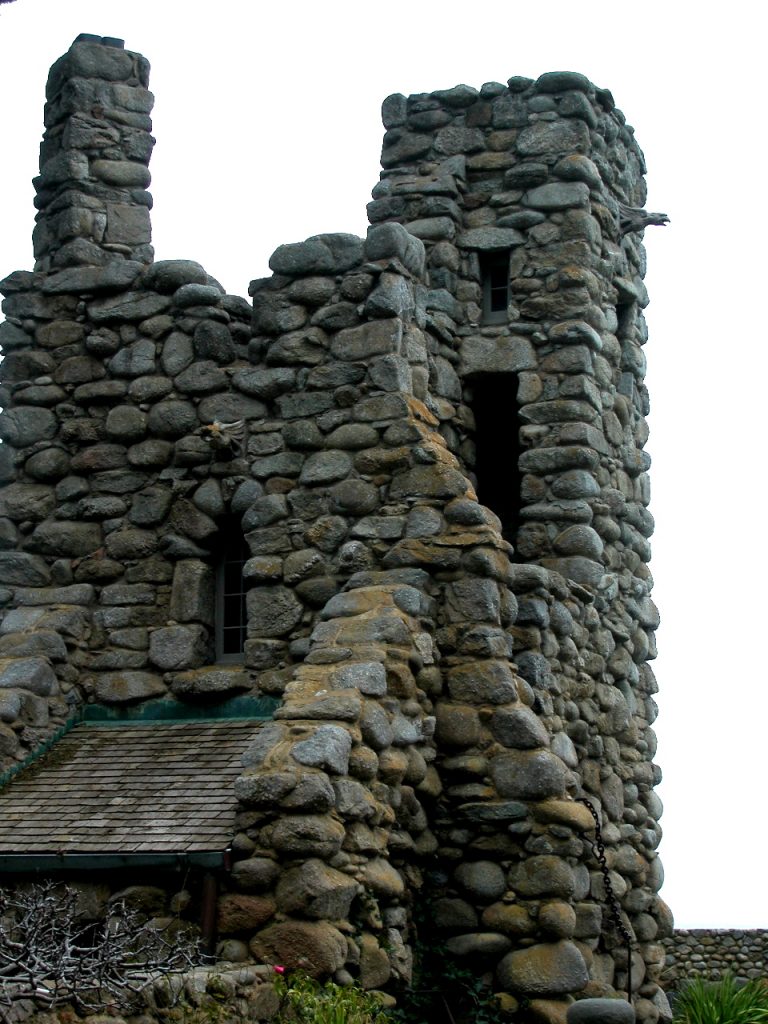In his day, Robinson Jeffers (1887-1962) was one of the nation’s best-loved poets.
He was known mainly for his epic Greek-style poems, modern-day tragedies based on California’s central coast.
He toiled in obscurity, then hit it big around the age of 37, when “Tamar and Other Poems” became a best-seller. Six years later, he was on the cover of Time.
He and his wife, Una, came to Carmel in 1914. After their twin sons were born in 1916, they bought land on an isolated, wind-swept promontory. There were no paved roads, no trees, no neighbors.
Jeffers began hauling stones up the hill from the beach by hand. With no written plans and no formal training in architecture or construction, he built an English garden-style cottage (later expanded) and, from 1920-1924, an adjacent tower of granite.
Tor House he called it, “tor” being a Celtic word meaning “outcropping of rock.”
Today you can take a docent-led tour of Tor House and Hawk Tower on Fridays or Saturdays, reservations required.
Here, you can learn all about the Jeffers’ backstory, which began with a scandal (Una was married when they met; her ex-husband, an LA lawyer, ended up building his own stone house right down the street).
Neither of the Jeffers were “religious,” but rather “spiritual.” Una, for example, was drawn to unicorns. Wikipedia notes that Jeffers’ philosophy of “inhumanism” was based on the belief that “transcending conflict required human concerns to be de-emphasized in favor of the boundless whole.”
The front garden sets the tone. Friends brought “items of interest” from all over the world, and the Jeffers incorporated them into the house and grounds. A slab of granite from the underside of the officers’ billiard table at Fort Ord has been fashioned into a bench.
A child’s grave marker, stones from Una’s family farm in Michigan, and shards of green glazed tile from the Temple of Heaven in Beijing are set into pathways, walls, and cornices.
Inside, all the furniture and fixtures are original.
The Jeffers were hardy folk. For years, the living room — Oriental rugs, wood floors, Steinway piano — was also the dining room. Its smallish fireplace sufficed to heat the whole house. The place didn’t have electricity until 1948.
They were also, mostly by necessity, frugal. The guest room, directly off the living room, is small. The windows overlook the ocean. Guests shared the one bathroom with the Jeffers.
The kitchen, featuring a spinning wheel that belonged to Una’s mother, was added in 1935. Even so, Una cooked on a propane stove. The stone walls and clay-tiled floor exuded a penetrating cold and damp on a January day.
Jeffers wrote each morning from nine till noon. (What eventually became the family’s upstairs living quarters, with his workspace and desk, are off-limits to visitors).Then he took lunch and did hard physical labor for several hours.
I consider myself fairly spry, but climbing the stone steps to Hawk Tower I practically had to hoist my legs by hand from step to high, winding step. The view and the Old World, handcrafted space were worth it.
Una had a tiny aerie, high above, where she could remove herself from the fray, have tea with her girlfriends, and no doubt give thanks for such an artistically creative spouse.
Around 1948 Una got sick. They moved her to the downstairs bedroom, where she died in 1950. Jeffers never slept upstairs again.
He, too, died in the guest-room bed, a conscious choice. Thirty years before, he’d written “The Bed by the Window.”
The poem begins:
“I chose the bed downstairs by the sea-window for a good death-bed
When we built the house, it is ready waiting,
Unused unless by some guest in a twelvemonth, who hardly suspects
Its latter purpose.”
I tremendously admire Jeffers’ asceticism, tireless labor, and love for solitude, beauty, and the land. And yet, the whole left me a little cold.
He once said he’d rather kill a man than a hawk. And though anyone who’s ever, say, contended with LA traffic knows what he means, there is a chill, a mania for control at the center of his life and work that perhaps prevented him from becoming a truly great poet.
His work fell out of favor in the early ’50s, when personal, confessional poetry became popular.
And his splendid isolation was not to last. He was purportedly crushed when in 1951 the showpiece “Butterfly House” — all steel and glass — was built just below Hawk Tower. Multimillion-dollar homes, in a jumble of styles, sit cheek-by-jowl now, all the way up Ocean View Avenue.
He’d turn over in his grave if he could take a stroll through downtown Carmel, lousy with boutiques hawking makeup and jewelry, high-end restaurants, and dogs whose monthly grooming bill would probably have kept the Jeffers in food for a year.
Still, the house and tower stand, monuments to the indomitable spirit of this giant of a man. “[T]he heart-breaking beauty [of nature] will remain,” he wrote, “when there is no heart to break for it.”
Oh — but there always will be.
Heather King is a blogger, speaker and the author of several books. For more, visit heather-king.com.
SPECIAL OFFER! 44 issues of Angelus for just $9.95! Get the finest in Catholic journalism with first-rate analysis of the events and trends shaping the Church and the world, plus the practical advice from the world’s best spiritual writers on prayer and Catholic living, along with great features about Catholic life in Los Angeles. Subscribe now!

